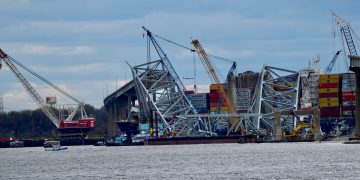The National Transportation Safety Board (NTSB) has released an investigation report on an incident where, on February 17, 2023, while the Desperado was transiting Lake Salvador on the Intracoastal Waterway in Bayou Perot, Louisiana, a fire occurred in the engine room that the crew was not able to extinguish, and the crew evacuated the vessel.
The incident
The three crewmembers aboard were unable to extinguish the fire with portable extinguishers. They secured ventilation and fuel to the engine room and then evacuated to a Good Samaritan vessel. When a responding fire boat arrived, the fire was out. No pollution or injuries were reported. Damage to the vessel totaled $30,000.
After the fire alarm sounded in the wheelhouse and the captain observed smoke, he immediately shut down the main propulsion engines, which stopped the
hydraulic pumps that were mechanically driven off them, thereby stopping the spraying hydraulic oil from reaching the engines and fueling the fire. He then
directed the deckhands to secure ventilation and the emergency fuel shut off valves— effectively stopping additional air and diesel fuel from entering the engine room. When inspecting the damage after the fire, the crew found damage was limited to the area of the port main propulsion engine, and, according to the captain, “Except the one [port] engine that was burnt, everything else was pretty much normal.” Therefore, the crew’s prompt actions to remove the fuel and oxygen sources for the fire helped limit the fire damage and extinguish the fire.
The captain told the Coast Guard that the cause of the fire was a ruptured hydraulic line on the portside steering pump, which subsequently caused flammable
hydraulic oil to spray onto the hot port main propulsion engine exhaust manifold and turbocharger and ignite.
After the hydraulic steering system was refurbished in late 2022, there were no reported issues other than a few minor hydraulic leaks that required tightening of fittings or connections. The captain said that no alterations were made to the steering gear system after install. The hose that ruptured was manufactured on October 7, 2018. It is unknown when this hose was installed; however, based on the manufacture date being 4 years before the refurbishment work, it is unlikely that the older hose was installed during the 2022 refurbishment.
Conclusions
Probable Cause
The National Transportation Safety Board determines that the probable cause of the fire aboard the towing vessel Desperado was a hydraulic hose that likely
exceeded its bend radius, eventually causing the hose to rupture, resulting in hydraulic oil spraying onto a hot engine exhaust manifold and turbocharger and
igniting.
Lessons Learned
Following Manufacturer Guidance for Hydraulic Hose Installation Mariners and technicians who design, install, and maintain systems should follow the manufacturer’s guidance on the minimum bend radius for a hydraulic hose. The minimum bend radius is the radius below which an object cannot (or should not) be bent. Bending or flexing a hose to a radius smaller than the minimum recommended, or subjecting a hose to tension or torque, can place excessive stress on the hose and severely reduce the ability of the hose to withstand pressure. Tight space constraints may cause a hose to bend severely around corners. A machine or cylinder extending and retracting can also bend a hose. Hoses attached to moving parts may bend more than a hose in or near a machine’s stationary position. Actions to avoid hose damage or failure include clamping a hose in place to provide support, rerouting a hose assembly by installing fittings and adapters, and using a hose with more reinforcement (two braid instead of one braid).

































































